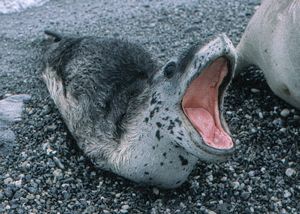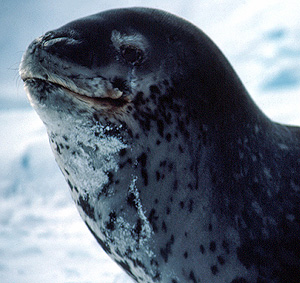Leopard Seal (Hydruga leptonyx) on an ice-floe
Back to gallery Back to crabeater seal thumbnails Next Previous

A juvenile leopard seal probably only recently left its mother showing the wide gape (and current lack of adult teeth!)

Adult leopard seal with the characteristic permanent "grin"
Named for the spotting on its underside and the wide gape
that displays a mouth full of sharp teeth, the Leopard Seal
is one of the largest predators in Antarctica, smaller only
than the killer whale. Females are larger than males and average
about 3m (10ft) long and around 350kg (770lb). They appear more
squat when on the surface as in this picture on an ice floe,
where they are nearly always seen, only rarely coming ashore
onto land. In the sea, they appear longer, sleeker and almost
snake-like in form and movements, though they swim of course
with fore and hind flippers. Leopard seals are built for speed,
they have a large powerful head, a huge gape and a massive lower
jaw.
They frequent the edge of the pack ice and in particular
areas around penguin rookeries all around Antarctica. They are
fairly opportunistic as predators and will east a wide variety
of prey from krill to penguins to young crabeater seals - their
main prey. Their teeth are very much those of a carnivore, though
they are also partly adapted with three large cusps on the pre-molars
and molars that interlock and are also able to act as a strainer
when feeding on krill. They are inquisitive and fearless, frequently
approaching small boats to investigate when their large "grin"
and all of those teeth they have can make them appear quite
menacing. Their way of dealing with penguins is quite gruesome.
Once caught and killed, the penguin is shaken violently from
side to side by the leopard seal until it is literally thrown
out of its skin and feathers for the seal to then swallow. Floating
penguin skins in the sea are a sure sign of leopard seals nearby.
Photo; © Paul Ward
